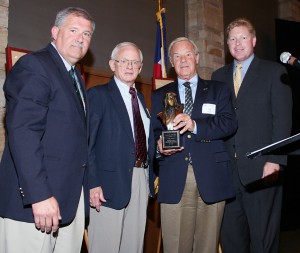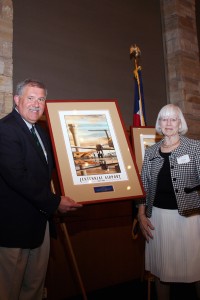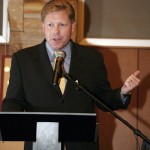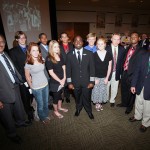
L to R: Robert Olislagers, Larry Ulrich, Jim Jeppesen and Chris Dunn. Ulrich accepted the Captain Elrey Jeppesen Award from Jeppesen, Elrey Jeppesen’s son, due to his efforts to push legislation to make ELTs mandatory, saving countless lives.
By Sean Settle
More than 30,000 spectators braved heavy traffic and overcast skies on May 12, 1968, for the grand opening of Arapahoe County Airport (APA). The left landing gear of a plane piloted by stunt pilot Dick Rutt neatly cut a ribbon held by two men on opposite sides of the sprawling 4,200-foot runway to officially get things started.
Now, more than 40 years later, Arapahoe County Airport—known as Centennial Airport since 1975, due to expansions that crossed the border of Douglas County—is ranked the third business general aviation airport and among the 25 busiest of all types of airports in the United States.
On May 28, 2008, more than 450 people gathered to honor the storied history of “the airport that could.” Hosted by Centennial Airport, the South Metro Denver Chamber of Commerce and the Wildlife Experience, the event took place at the Wildlife Experience. Distinguished faces on hand included former and current airport commissioners, local and state government officials, founding airport supporters, aviation businesses, local aviation personalities and aviation enthusiasts.
Keynote speaker Barrington Irving, the youngest person ever and the first black pilot to solo round the world, gave a remarkable and fascinating account of his record-setting experience.

Centennial Airport Director Robert Olislagers presents an award to Dr. Gwen Mayo, honoring her years of pioneering work and commitment to aviation.
An awards ceremony during the catered luncheon paid homage to a number of Centennial’s founding individuals, as well those who have supported the airport over the years. Award recipients included Dr. Gwen Mayo, Bill Payne, Travis Vallin and Larry Ulrich.
Dr. Gwen Mayo is chair of Mayo Aviation, after having served as chief financial officer and CEO since its founding in the mid-1970s. From humble days beginning with the leasing of two aircraft, Mayo Aviation has become one of the most success charter companies in America. She’s a member of the board of directors of the National Air Transportation Association and is an inductee of the Colorado Aviation Hall of Fame.
William E. “Bill” Payne began his career in aerospace engineering at Martin Marietta, involved in the structural design of spacecraft elements on the Viking Mars Lander and Skylab. Payne worked tirelessly to promote Centennial Airport in many capacities.
He’s served as chairman of the Centennial Airport Business Association for many years and was often front and center on many debates over the potential arrival of scheduled airline service. He also wrote the development standards for Centennial, which serve as the standard now for many other airports.
As an engineer and principal in charge, Payne has completed more than 100 projects at Centennial, including hangars, the runway and taxiway projects, just to name a few. Most recently, Payne has worked closely with the Colorado Division of Aeronautics to bring multilateration radar to the Rocky Mountains to make mountain flying safer.
Travis Vallin, the director of Aeronautics for the State of Colorado, was recognized for his work with Payne to establish a radar surveillance system in the mountains to improve the safety of mountain flying.

L to R: Bill Payne accepts his award from Robert Olislagers and emcee Chris Dunn, honoring his career in aerospace engineering and expansion of the safety radar system in the Rocky Mountains of Colorado.
Larry Ulrich, senior VP of Rocky Mountain jetCenters, received the prestigious Captain Elrey Jeppesen Award from Jim Jeppesen, son of the late great aviation pioneer Elrey Jeppesen, for his persistence in convincing the Federal Aviation Administration to require emergency locator transmitters be installed on every aircraft today. His efforts to push legislation to make ELTs mandatory are credited with saving countless lives of downed and lost pilots.
“The airport was very honored to be able to recognize Dr. Gwen Mayo, Travis Vallin, Bill Payne and Larry Ulrich for contributing to making Centennial Airport what it is today, and for what they have done and continue to do for general aviation as a whole,” Olislagers said.
Silent auctions included commemorative and signed limited edition posters by well-known aviation artist Joe Jones and specially made taxiway desk lights. More than $5,000 was raised in support of the Centennial Airport Foundation, which promotes aviation education.
“We had a fabulous turnout, from every segment of our community—our citizen neighbors, elected officials, airport tenants, industry representatives and developers,” Olislagers said. “It stands as a testament of what one can do when you work together.”
History

Travis Vallin (left), director of Aeronautics for the State of Colorado, received an award for his many contributions to Colorado airports.
When George Wallace paid $80,000 for 40 acres of barren prairie near I-25 and East Belleview Avenue, his vision was to build a place where people could work in an atmosphere that would stimulate creative processes. Friends and critics thought the idea was crazy; the site was too far away from the frenzied business district in Denver that Wallace hated. With the help of designers, architects, and engineers, he proved them wrong.
Wallace transformed the wasteland into a modern suburban office complex in a campus-like setting away from the hustle and bustle of downtown Denver, drawing companies such as Hewlett-Packard, Eastman Kodak, Johns-Manville, Texaco and 3M to the Denver Tech Center. One of the earliest landscaped technological parks in the nation, DTC is now one of the largest and busiest.
A pilot who loved to fly, Wallace was also aware that many of his tenants were executives who traveled extensively. He soon became heavily involved, along with Arapahoe County Commissioners John Christiansen, Harold Abbott and John Nicholl, in getting an airport for Arapahoe County approved. They reasoned that an airport would relieve busy Stapleton of its heavy load and increase industry and revenue in the county. The airport was finally approved and construction began in 1967.
After World War II, Lou Clinton saw a future in selling private aircraft. With another former U.S. Army flight instructor, he founded Clinton Aviation in 1944. They used three war surplus PT-19s, a Rearwin Sportster and a Beech biplane for charter work at Stapleton Air Field in Denver.
The flight-training program, which included courses in mountain flying and aerobatics, would see more than 12,000 pilots over the next 30 years. The company also became the Cessna distributor for Colorado and Wyoming and received several awards for being among the top 10 Cessna dealers in the United States. In later years, Clinton Aviation sold Aerostar, Citabria, Mitsubishi and Learjet aircraft.

Lou Clinton, pictured with son Rob, founded Clinton Aviation, the first fixed base operation at Centennial Airport (then Arapahoe County). The Denver jerCenter is now located in the former Clinton Aviation facilities.
Although Clinton Aviation thrived at Stapleton, major growth combined with the threat of restrictions being placed on general aviation at the airport worried Clinton. When he heard that an airport was being built that would cater to private and small business aircraft, Clinton’s team analyzed the best fixed base operators coast-to-coast and decided to come up with a completely new concept. He drew up a proposal, met with Wallace and the board of Arapahoe County commissioners and put in his bid as the fixed based operator. It was accepted over two other bids.
His FBO, housed in two octagonal buildings and one 10-sided building, included a flight school and a spectacular showroom large enough to display 10 aircraft. The FBO offered a complete line of services, a new ramp able to accommodate 100 aircraft, storage hangars, outdoor tie-down areas and plane ports with a 300-airplane capacity.
Clinton Aviation would soon be recognized across the nation for its innovative design, taking Arapahoe County Airport with it into a new aviation era.
- KDVR FOX 31 chief meteorologist Chris Dunn was the emcee for the event.
- More than 450 guests packed the main exhibition hall at the Wildlife Experience for the 40th anniversary celebration luncheon.
- Special guests included Joe Suchman (left), Cherry Creek High School Aviation Program instructor, and his student, pictured with pilot Barrington Irving (center) and Robert Olislagers (far right).
- Keynote speaker Barrington Irving recounted his amazing journey into aviation, which eventually led to him becoming the youngest person ever and the first black pilot to fly solo around the world.















